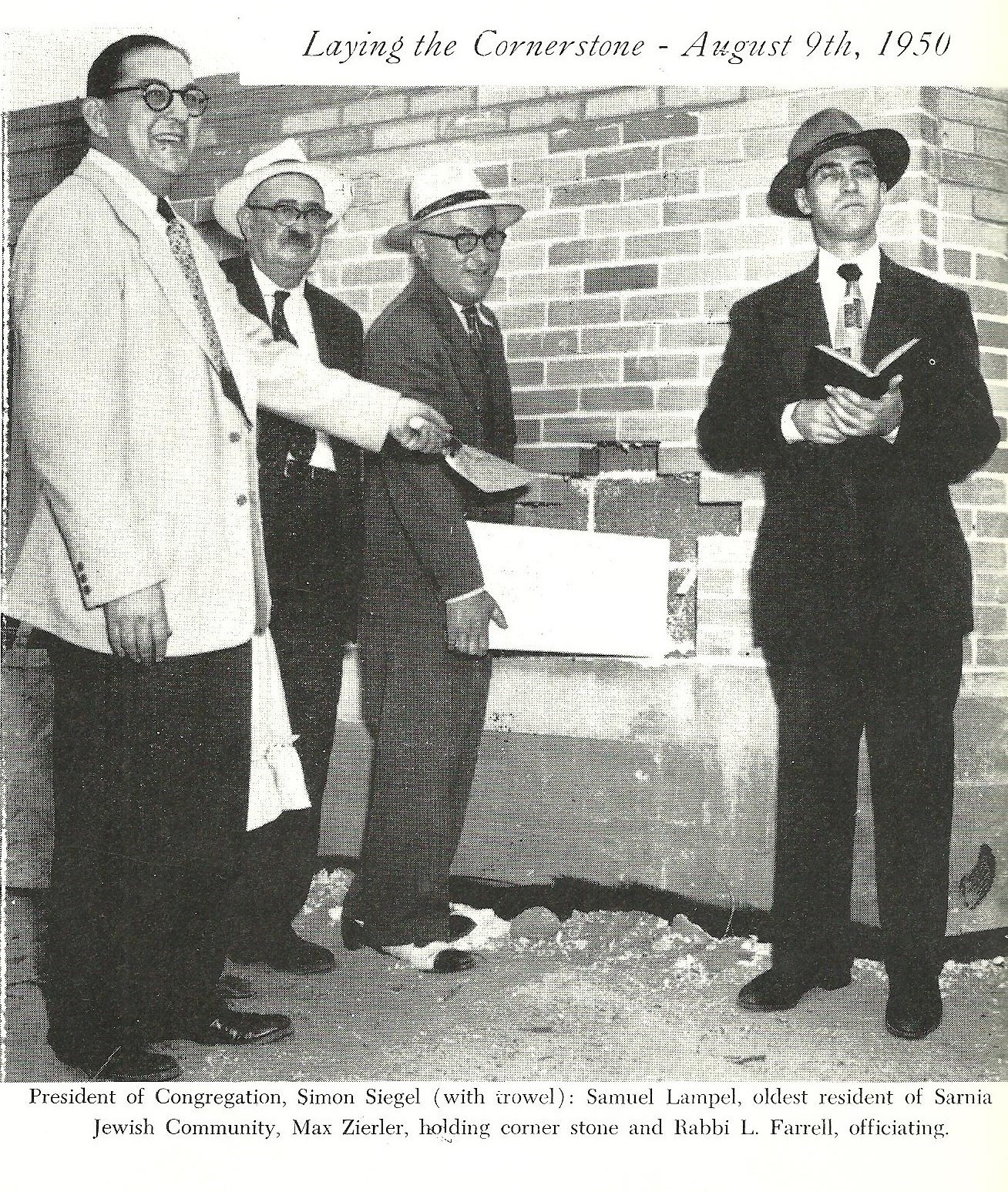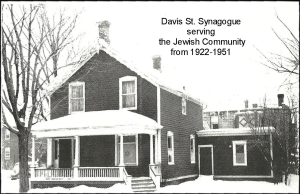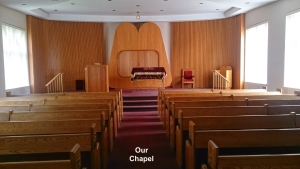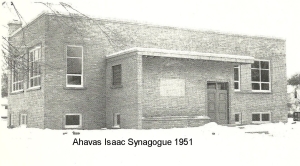By Jeffrey M. Rottman
While investigating the history behind the Jewish Community of Sarnia, I have realized that it is an on-going experience with so many variables. Having lost valuable references through death or relocation, of important members of our community, I can only surmise. I will endeavor to tell you, with the information I have available, about some of the interesting folks who immigrated to Sarnia from various places and became prominent members of the community.
It all began as a child living in a Jewish home in London, Ontario. My parents were not terribly religious but my family would celebrate Jewish holy days, (Rosh Hashanah – the Jewish New Year; Yom Kippur – the Day of Judgment; Hanukkah – the Festival of Light; and Passover – the Festival of Liberation,) similar to other Jewish families in the community. I enjoyed accompanying my father to the synagogue once a week, and I also attended Hebrew School four days a week until I celebrated my Bar Mitzvah, at the age of 13. It wouldn’t be for another 26 years, that I would attend a service at a synagogue.
It was 1991, I was living in Sarnia, already married with three children, and my eldest son was eight years old. My wife and I decided that he was at the perfect age to attend Hebrew School at Ahavas Isaac Synagogue, at the corner of Cobden and Mackenzie Streets. After that, we were new members of the synagogue and proceeded to enroll my other two children in the Hebrew School, when they reached the age of eight. They were instructed by Rabbi David Mann and learned Hebrew, prayers and about their Jewish roots, just as I had done as a boy, in London. Learning about my roots, today, has been an interesting compilation of photos and genealogy.
Previous to that experience, the only other connection to the community was the fact that Robert and Thelma Slipacoff were instrumental in helping us get acquainted with other Jewish members here in Sarnia. Thelma’s father was Michael Shabsove and, just to show that it is a small world, he married my grandmother in 1951, in London, after his wife had died and just before I was born.
Uncle Mike, as I called him, had been an early settler to this area, especially in Petrolia. He started the scrap metal business there in 1917 and called it The Petrolia Iron and Metal Company. The company would eventually move to Sarnia and be taken over by his children and grandchildren. In his book entitled, “A History of the Jewish Community of London, Ontario”, Bill Gladstone states that “Hymie Shabsove, who had arrived from Minsk, in Russia, came to London to find his older brother, Michael, who persuaded him to join him as a partner in Petrolia in the scrap metal business.” Hymie’s two sons became prominent members of that community. George, the eldest, was a popular mayor in the sixties, and Harold became an excellent doctor there. Descendants of the Shabsove brothers are today found in Petrolia, Sarnia, Toronto and other cities.
The story tells of a stream of immigrants from Russia, like my Uncle Mike Shabsove, and his brother Hymie, coming to Canada, in the wake of an epidemic of pogroms that swept across the empire of Alexander III, spreading devastation, terror, and murder to some 160 Jewish communities. In less than a decade following these excesses, some 600,000 Jews sought refuge in the United States and a sizable number also overflowed into Canada.
During the period of 1901 until the early 1920s, many cities in southern Ontario increased their Jewish populations as more and more people fled Eastern Europe and Russia, as did my own grandparents and great-grandparents. As immigrants settled in places like London, Toronto, Hamilton, Windsor and Sarnia, to name a few, being brought over the Atlantic Ocean by relatives who were already here, they had prospects of business opportunities in mind, in order to make a living in a strange, new land they called Canada. By 1931, Sarnia’s Jewish population had over 100 people. Many of the newcomers – and that is also true of later arrivals – did not take root in their new abode. They left to find permanent homes elsewhere. It has been suggested, for example, that in Detroit alone, there were more former Jewish Londoners and their descendants than in London itself. Nevertheless there were enough Jews in London by the end of the 1880s to establish two basic institutions, a cemetery and a synagogue, which were founded in this order.
Another prominent member of the Sarnia Jewish Community, Louis Slobasky, arrived in London in 1903, from Kishinev, in Russia. He was a peddler who travelled widely through this area by horse and buggy. He happened to meet his wife, Bessie, after bumping into her step-father, Max Zierler, another peddler, but from Sarnia. Max would become the Chairman of the Building Committee and lay the cornerstone when the Jewish people of Sarnia decided to begin building the new synagogue at Cobden and Mackenzie Streets, in 1950. Louis, and his son Max Slobasky, joined together to form Sarnia Auto Wreckers, on Campbell St. and were also founding members of the synagogue. Many other families were intertwined including several Zierlers and their kin who included Samuel and Gittel (Zierler) Lampel. Rosie Lampel, Samuel’s sister, married Abraham Heller in 1904, and settled in Sarnia. Samuel Lampel and Sons were dealers in junk and household furnishing goods, originally on Euphemia St. The Lampels and Zierlers owned a furniture store on Front St. later moving to Christina St. as a furniture exchange.
Other members of the Jewish Community established businesses and shops in Sarnia. Harold Cohen, our oldest member at the present, remembers beginning his construction company in the late fifties and sixties. He was the only person at the time to deal with insurance claims here when others wouldn’t. Esther Cohen, not related, who recently moved to Toronto, was an avid member of the synagogue and worked tirelessly to help maintain the continuation of the present day “Shul”. She and her husband, Mel, managed a Clothing Store which also sold wedding dresses, in downtown Sarnia.
The History of the Synagogue began in 1922, at a house on Davis St. and also served as a community center for Sarnia’s Jewish Community. As the years progressed, and until the late forties, the Jewish community in Sarnia was looking to expand and build a synagogue to accommodate all their members. The cornerstone of the new Ahavas Isaac Synagogue, at the northeast corner of Cobden and Mackenzie Streets, was laid on August 9, 1950, by Max Zierler, assisted by S. Siegal, President of the congregation and Samuel Lampel, oldest member of the congregation. Present for the ceremony was Mr. Bryan Cathcart, M.P.P. for Lambton West, S. Siegal, President, Sam Lampel, who broke the ground, Mayor W.C. Nelson, Rabbi Louis Farrell and members of the Jewish community.
It was dedicated on April 8, 1951, and was the proudest moment for many, culminating years of planning. Since that time, there have been many presidents leading the community: Sy Siegel, Abe Lampel, Marty Kaplan, Alvin Fox, Jack Pasternak (for 30 years) and Len Segall, the present president. Various Rabbis have also served the community, such as: Rabbi Granatstein, Rabbi Roness, Rabbi L. Farrell, Rabbi Halpern, Rabbi Matts, Rabbi Pavey, and Rabbi David Mann, who served the community for 17 years until 2005. Dave Zierler recalls in an article taken from the 25th Anniversary book of Ahavas Isaac Synagogue, in 1976, that “In the ‘50’s and ‘60’s, the focal point of Jewish people in Sarnia was the synagogue with many community functions being held there. The membership grew during that time and at one time numbered about eighty members.”
Since the war ended in 1945, Jewish people who passed away in Sarnia were taken to London, their bodies prepared by a group of dedicated Jewish Londoners, called the Chevra Kaddisha or Burial Society, of which my parents were members, and interred at the Or Shalom Cemetery on Oxford St. W. I remember my father explaining to me as to why he became a member of the Burial Society in 1951, after hearing of the death of two prominent Jewish leaders in London. They were walking one day, in March, and someone hit them both, killing them, and fleeing the scene. It was a very tragic moment for that community and my father felt a great obligation to get involved with the burial society, as did my mother. She would help sew shrouds to wrap the bodies in. Jewish tradition states that when a person dies, this process, called tahara (purification), involves the ritual cleaning of the corpse, by men for males and by women for females. Despite the fact that there are so many divisions in Jewish congregations, when a person dies, the community works together in harmony nevertheless.
By 1995, the Synagogue reached a maximum membership but has since diminished drastically. Three prominent Jewish Organizations were active in the community during those years: the Sisterhood of Ahavas Isaac, of which my wife was a member, and Hadassah and B’nai Brith Chapters of Sarnia.
People like Esther Cohen, Ricky Pasternak and Thelma Slipacoff, helped to keep them functioning. During the past ten years, Dr. Bill Klein and his wife Rose, from London, have travelled to Sarnia, usually on a monthly basis, to lead our tiny community in prayer. We are quite fortunate and pleased to have a small number of Jewish members attend on Saturdays, and some who join us from Port Huron, since their synagogue dissolved many years ago.
Thanks to families like the Pasternaks, who have since relocated to London, the Slipacoffs and many others for their allegiance and generous donations over the years, the present day Jewish community of Sarnia, which consists of a very few members, can still rejoice at the synagogue today although with infrequent services. Next year, we will celebrate the 65th Anniversary of Ahavas Isaac Synagogue, and as Director of Religious Practice, I commend our small group of followers for keeping the Synagogue alive and I hope that we make it until that day, on April 8, 2016, and beyond!





